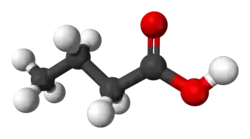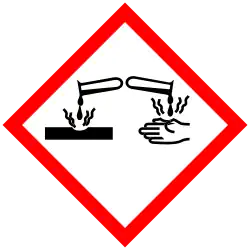Butyric acid
| |||
 | |||
| Names | |||
|---|---|---|---|
| Preferred IUPAC name
Butanoic acid[1] | |||
| Other names | |||
| Identifiers | |||
3D model (JSmol)
|
| ||
| ChEBI |
| ||
| ChEMBL |
| ||
| ChemSpider | |||
| DrugBank |
| ||
| ECHA InfoCard | 100.003.212 | ||
| EC Number |
| ||
| |||
| KEGG |
| ||
| MeSH | Butyric+acid | ||
PubChem CID
|
|||
| RTECS number |
| ||
| UNII |
| ||
| UN number | 2820 | ||
CompTox Dashboard (EPA)
|
| ||
| |||
| |||
| Properties | |||
| C 3H 7COOH | |||
| Molar mass | 88.106 g·mol−1 | ||
| Appearance | Colorless liquid | ||
| Odor | Unpleasant, similar to vomit or body odor | ||
| Density | 1.135 g/cm3 (−43 °C)[2] 0.9528 g/cm3 (25 °C)[3] | ||
| Melting point | −5.1 °C (22.8 °F; 268.0 K)[3] | ||
| Boiling point | 163.75 °C (326.75 °F; 436.90 K)[3] | ||
| Sublimes at −35 °C ΔsublH | |||
| Miscible | |||
| Solubility | Miscible with ethanol, ether. Slightly soluble in CCl4 | ||
| log P | 0.79 | ||
| Vapor pressure | 0.112 kPa (20 °C) 0.74 kPa (50 °C) 9.62 kPa (100 °C)[4] | ||
Henry's law
constant (kH) |
5.35·10−4 L·atm/mol | ||
| Acidity (pKa) | 4.82 | ||
| −55.10·10−6 cm3/mol | |||
| Thermal conductivity | 1.46·105 W/m·K | ||
Refractive index (nD)
|
1.398 (20 °C)[3] | ||
| Viscosity | 1.814 cP (15 °C)[5] 1.426 cP (25 °C) | ||
| Structure | |||
| Monoclinic (−43 °C)[2] | |||
| C2/m[2] | |||
a = 8.01 Å, b = 6.82 Å, c = 10.14 Å[2] α = 90°, β = 111.45°, γ = 90°
| |||
| 0.93 D (20 °C)[5] | |||
| Thermochemistry | |||
Heat capacity (C)
|
178.6 J/mol·K[4] | ||
Std molar
entropy (S⦵298) |
222.2 J/mol·K[5] | ||
Std enthalpy of
formation (ΔfH⦵298) |
−533.9 kJ/mol[4] | ||
Std enthalpy of
combustion (ΔcH⦵298) |
2183.5 kJ/mol[4] | ||
| Hazards | |||
| GHS labelling: | |||
 [6] [6]
| |||
| Danger | |||
| H314[6] | |||
| P280, P305+P351+P338, P310[6] | |||
| NFPA 704 (fire diamond) | |||
| Flash point | 71 to 72 °C (160 to 162 °F; 344 to 345 K)[6] | ||
| 440 °C (824 °F; 713 K)[6] | |||
| Explosive limits | 2.2–13.4% | ||
| Lethal dose or concentration (LD, LC): | |||
LD50 (median dose)
|
2000 mg/kg (oral, rat) | ||
| Safety data sheet (SDS) | External MSDS | ||
| Related compounds | |||
Related carboxylic acids
|
Propionic acid, Pentanoic acid | ||
Related compounds
|
1-Butanol Butyraldehyde Methyl butyrate | ||
Except where otherwise noted, data are given for materials in their standard state (at 25 °C [77 °F], 100 kPa).
Infobox references
| |||
Butyric acid (/ˈbjuːtɪrɪk/; from Ancient Greek: βούτῡρον, meaning "butter"), also known under the systematic name butanoic acid, is a straight-chain alkyl carboxylic acid with the chemical formula CH3CH2CH2COOH. It is an oily, colorless liquid with an unpleasant odor. Isobutyric acid (2-methylpropanoic acid) is an isomer. Salts and esters of butyric acid are known as butyrates or butanoates. The acid does not occur widely in nature, but its esters are widespread. It is a common industrial chemical[7] and an important component in the mammalian gut.
History
Butyric acid was first observed in an impure form in 1814 by the French chemist Michel Eugène Chevreul. By 1818, he had purified it sufficiently to characterize it. However, Chevreul did not publish his early research on butyric acid; instead, he deposited his findings in manuscript form with the secretary of the Academy of Sciences in Paris, France. Henri Braconnot, another French chemist, was also researching the composition of butter and was publishing his findings and this led to disputes about priority. As early as 1815, Chevreul claimed that he had found the substance responsible for the smell of butter.[8] By 1817, he published some of his findings regarding the properties of butyric acid and named it.[9] However, it was not until 1823 that he presented the properties of butyric acid in detail.[10] The name butyric acid comes from βούτῡρον, meaning "butter", the substance in which it was first found. The Latin name butyrum (or buturum) is similar.
Occurrence
Triglycerides of butyric acid make up 3–4% of butter. When butter goes rancid, butyric acid is liberated from the glyceride by hydrolysis.[11] It is one of the fatty acid subgroup called short-chain fatty acids. Butyric acid is a typical carboxylic acid that reacts with bases and affects many metals.[12] It is found in animal fat and plant oils, bovine milk, breast milk, butter, parmesan cheese, body odor, vomit and as a product of anaerobic fermentation (including in the colon).[13] It has a taste somewhat like butter and an unpleasant odor. Mammals with good scent detection abilities, such as dogs, can detect it at 10 parts per billion, whereas humans can detect it only in concentrations above 10 parts per million. In food manufacturing, it is used as a flavoring agent.[14]
In humans, butyric acid is one of two primary endogenous agonists of human hydroxycarboxylic acid receptor 2 (HCA2), a Gi/o-coupled G protein-coupled receptor.[15][16]
Butyric acid is present as its octyl ester in parsnip (Pastinaca sativa)[17] and in the seed of the ginkgo tree.[18]
Production
Industrial
In industry, butyric acid is produced by hydroformylation from propene and syngas, forming butyraldehyde, which is oxidised to the final product.[7]
It can be separated from aqueous solutions by saturation with salts such as calcium chloride. The calcium salt, Ca(C4H7O2)2 · H2O, is less soluble in hot water than in cold.
Microbial biosynthesis

Butyrate is produced by several fermentation processes performed by obligate anaerobic bacteria.[19] This fermentation pathway was discovered by Louis Pasteur in 1861. Examples of butyrate-producing species of bacteria:
- Clostridium butyricum
- Clostridium kluyveri
- Clostridium pasteurianum
- Faecalibacterium prausnitzii
- Fusobacterium nucleatum
- Butyrivibrio fibrisolvens
- Eubacterium limosum
The pathway starts with the glycolytic cleavage of glucose to two molecules of pyruvate, as happens in most organisms. Pyruvate is oxidized into acetyl coenzyme A catalyzed by pyruvate:ferredoxin oxidoreductase. Two molecules of carbon dioxide (CO2) and two molecules of hydrogen (H2) are formed as waste products. Subsequently, ATP is produced in the last step of the fermentation. Three molecules of ATP are produced for each glucose molecule, a relatively high yield. The balanced equation for this fermentation is
Other pathways to butyrate include succinate reduction and crotonate disproportionation.
| Action | Responsible enzyme |
|---|---|
| Acetyl coenzyme A converts into acetoacetyl coenzyme A | acetyl-CoA-acetyl transferase |
| Acetoacetyl coenzyme A converts into β-hydroxybutyryl CoA | β-hydroxybutyryl-CoA dehydrogenase |
| β-hydroxybutyryl CoA converts into crotonyl CoA | crotonase |
| Crotonyl CoA converts into butyryl CoA (CH3CH2CH2C=O−CoA) | butyryl CoA dehydrogenase |
| A phosphate group replaces CoA to form butyryl phosphate | phosphobutyrylase |
| The phosphate group joins ADP to form ATP and butyrate | butyrate kinase |
Several species form acetone and n-butanol in an alternative pathway, which starts as butyrate fermentation. Some of these species are:
- Clostridium acetobutylicum, the most prominent acetone and butanol producer, used also in industry
- Clostridium beijerinckii
- Clostridium tetanomorphum
- Clostridium aurantibutyricum
These bacteria begin with butyrate fermentation, as described above, but, when the pH drops below 5, they switch into butanol and acetone production to prevent further lowering of the pH. Two molecules of butanol are formed for each molecule of acetone.
The change in the pathway occurs after acetoacetyl CoA formation. This intermediate then takes two possible pathways:
- acetoacetyl CoA → acetoacetate → acetone
- acetoacetyl CoA → butyryl CoA → butyraldehyde → butanol
For commercial purposes Clostridium species are used preferably for butyric acid or butanol production. The most common species used for probiotics is the Clostridium butyricum.[20]
Fermentable fiber sources
Highly-fermentable fiber residues, such as those from resistant starch, oat bran, pectin, and guar are transformed by colonic bacteria into short-chain fatty acids (SCFA) including butyrate, producing more SCFA than less fermentable fibers such as celluloses.[13][21] One study found that resistant starch consistently produces more butyrate than other types of dietary fiber.[22] The production of SCFA from fibers in ruminant animals such as cattle is responsible for the butyrate content of milk and butter.[23]
Fructans are another source of prebiotic soluble dietary fibers which can be digested to produce butyrate.[24] They are often found in the soluble fibers of foods which are high in sulfur, such as the allium and cruciferous vegetables. Sources of fructans include wheat (although some wheat strains such as spelt contain lower amounts),[25] rye, barley, onion, garlic, Jerusalem and globe artichoke, asparagus, beetroot, chicory, dandelion leaves, leek, radicchio, the white part of spring onion, broccoli, brussels sprouts, cabbage, fennel, and prebiotics, such as fructooligosaccharides (FOS), oligofructose, and inulin.[26][27]
Chemical reactions
Butyric acid reacts as a typical carboxylic acid: it can form amide, ester, anhydride, and chloride derivatives.[28] The latter, butyryl chloride, is commonly used as the intermediate to obtain the others.
Uses
Butyric acid is used in the preparation of various butyrate esters. It is used to produce cellulose acetate butyrate (CAB), which is used in a wide variety of tools, paints, and coatings, and is more resistant to degradation than cellulose acetate.[29] CAB can degrade with exposure to heat and moisture, releasing butyric acid.[30]
Low-molecular-weight esters of butyric acid, such as methyl butyrate, have mostly pleasant aromas or tastes.[7] As a consequence, they are used as food and perfume additives. It is an approved food flavoring in the EU FLAVIS database (number 08.005).
Due to its powerful odor, it has also been used as a fishing bait additive.[31] Many of the commercially available flavors used in carp (Cyprinus carpio) baits use butyric acid as their ester base. It is not clear whether fish are attracted by the butyric acid itself or the substances added to it. Butyric acid was one of the few organic acids shown to be palatable for both tench and bitterling.[32]
The substance has been used as a stink bomb by the Sea Shepherd Conservation Society to disrupt Japanese whaling crews.[33] The Dutch branch of Extinction Rebellion has used it as a chemical agent in a clothing store; several people who became unwell were treated on site by an ambulance crew.[34]
Pharmacology
| Inhibited enzyme | IC50 (nM) | Entry note |
|---|---|---|
| HDAC1 | 16,000 | |
| HDAC2 | 12,000 | |
| HDAC3 | 9,000 | |
| HDAC4 | 2,000,000 | Lower bound |
| HDAC5 | 2,000,000 | Lower bound |
| HDAC6 | 2,000,000 | Lower bound |
| HDAC7 | 2,000,000 | Lower bound |
| HDAC8 | 15,000 | |
| HDAC9 | 2,000,000 | Lower bound |
| CA1 | 511,000 | |
| CA2 | 1,032,000 | |
| GPCR target | pEC50 | Entry note |
| FFAR2 | 2.9–4.6 | Full agonist |
| FFAR3 | 3.8–4.9 | Full agonist |
| HCA2 | 2.8 | Agonist |
Pharmacodynamics
Butyric acid (pKa 4.82) is fully ionized at physiological pH, so its anion is the material that is mainly relevant in biological systems. It is one of two primary endogenous agonists of human hydroxycarboxylic acid receptor 2 (HCA2, also known as GPR109A), a Gi/o-coupled G protein-coupled receptor (GPCR),[15][16]
Like other short-chain fatty acids (SCFAs), butyrate is an agonist at the free fatty acid receptors FFAR2 and FFAR3, which function as nutrient sensors that facilitate the homeostatic control of energy balance; however, among the group of SCFAs, only butyrate is an agonist of HCA2.[37][38] It is also an HDAC inhibitor (specifically, HDAC1, HDAC2, HDAC3, and HDAC8),[35][36] a drug that inhibits the function of histone deacetylase enzymes, thereby favoring an acetylated state of histones in cells.[38]
Pharmacokinetics
Butyrate that is produced in the colon through microbial fermentation of dietary fiber is primarily absorbed and metabolized by colonocytes and the liver[note 1] for the generation of ATP during energy metabolism; however, some butyrate is absorbed in the distal colon, which is not connected to the portal vein, thereby allowing for the systemic distribution of butyrate to multiple organ systems through the circulatory system.[38][39] Butyrate that has reached systemic circulation can readily cross the blood–brain barrier via monocarboxylate transporters (i.e., certain members of the SLC16A group of transporters).[40][41] Other transporters that mediate the passage of butyrate across lipid membranes include SLC5A8 (SMCT1), SLC27A1 (FATP1), and SLC27A4 (FATP4).[35][41]
Metabolism
Butyric acid is metabolized by various human XM-ligases (ACSM1, ACSM2B, ASCM3, ACSM4, ACSM5, and ACSM6), also known as butyrate–CoA ligase.[42][43] The metabolite produced by this reaction is butyryl–CoA, and is produced as follows:[42]
As a short-chain fatty acid, butyrate is metabolized by mitochondria as an energy (i.e., adenosine triphosphate or ATP) source through fatty acid metabolism.[38] In particular, it is an important energy source for cells lining the mammalian colon (colonocytes).[24] Without butyrates, colon cells undergo autophagy (i.e., self-digestion) and die.[44]
In humans, the butyrate precursor tributyrin, which is naturally present in butter, is metabolized by triacylglycerol lipase into dibutyrin and butyrate through the reaction:[45]
Biochemistry
Butyrate has numerous effects on energy homeostasis in humans. These effects occur through its metabolism by mitochondria to generate ATP during fatty acid metabolism or through one or more of its histone-modifying enzyme targets (i.e., the class I histone deacetylases) and G-protein coupled receptor targets (i.e., FFAR2, FFAR3, and HCA2).[37][46]
Mammalian gut
Butyrate is essential to host immune homeostasis.[37] Although the role and importance of butyrate in the gut is not fully understood, many researchers argue that a depletion of butyrate-producing bacteria in patients with several vasculitic conditions is essential to the pathogenesis of these disorders. A depletion of butyrate in the gut is typically caused by an absence or depletion of butyrate-producing-bacteria (BPB). This depletion in BPB leads to microbial dysbiosis. This is characterized by an overall low biodiversity and a depletion of key butyrate-producing members. Butyrate is an essential microbial metabolite with a vital role as a modulator of proper immune function in the host. It has been shown that children lacking in BPB are more susceptible to allergic disease[47] and type 1 diabetes.[48] Butyrate is also reduced in a diet low in dietary fiber, which can induce inflammation and have other adverse affects insofar as these short-chain fatty acids activate PPAR-γ.[49]
Decreased butyrate levels lead to a damaged or dysfunctional intestinal epithelial barrier.[50] Butyrate reduction has also been associated with Clostridioides difficile proliferation. Conversely, a high-fiber diet results in higher butyric acid concentration and inhibition of C. difficile growth.[51]
In the gut microbiomes found in the class Mammalia, omnivores and herbivores have butyrate-producing bacterial communities dominated by the butyryl-CoA:acetate CoA-transferase pathway, whereas carnivores have butyrate-producing bacterial communities dominated by the butyrate kinase pathway.[52]
The odor of butyric acid, which emanates from the sebaceous follicles of all mammals, works on ticks as a signal.
Immunomodulation
Butyrate's effects on the immune system are mediated through the inhibition of class I histone deacetylases and activation of its G-protein coupled receptor targets: HCA2 (GPR109A), FFAR2 (GPR43), and FFAR3 (GPR41).[53]
Colonocytes
Responsible for about 70% of energy from the colonocytes, butyric acid is a critical SCFA in colon homeostasis.[54] Short-chain fatty acids, which include butyric acid, are produced by beneficial colonic bacteria that feed on, or ferment prebiotics, supporting colonocytes by increasing energy conversion.[21]
Butyrate salts and esters
The butanoate ion, C3H7COO−, is the conjugate base of butyric acid. It is the form found in biological systems at physiological pH. A butyric (or butanoic) compound is a carboxylate salt or ester of butyric acid.
Examples
Salts
Esters
- Butyl butyrate
- Butyryl-CoA
- Cellulose acetate butyrate (aircraft dope)
- Estradiol benzoate butyrate
- Ethyl butyrate
- Methyl butyrate
- Pentyl butyrate
- Tributyrin
See also
- List of saturated fatty acids
- Histone
- Hydroxybutyric acids
- Oxobutyric acids
- 2-Oxobutyric acid (α-ketobutyric acid)
- 3-Oxobutyric acid (acetoacetic acid)
- 4-Oxobutyric acid (succinic semialdehyde)
- β-Methylbutyric acid
Notes
- ^ Most of the butyrate that is absorbed into blood plasma from the colon enters the circulatory system via the portal vein; most of the butyrate that enters the circulatory system by this route is taken up by the liver.[38]
References
This article incorporates text from a publication now in the public domain: Chisholm, Hugh, ed. (1911). "Butyric Acid". Encyclopædia Britannica (11th ed.). Cambridge University Press.
- ^ "Applications to Specific Classes of Compounds". Nomenclature of Organic Chemistry : IUPAC Recommendations and Preferred Names 2013 (Blue Book). Cambridge: The Royal Society of Chemistry. 2014. p. 746. doi:10.1039/9781849733069-00648. ISBN 978-0-85404-182-4.
- ^ a b c d Strieter FJ, Templeton DH (1962). "Crystal structure of butyric acid" (PDF). Acta Crystallographica. 15 (12): 1240–1244. Bibcode:1962AcCry..15.1240S. doi:10.1107/S0365110X6200328X.
- ^ a b c d Lide, David R., ed. (2009). CRC Handbook of Chemistry and Physics (90th ed.). Boca Raton, Florida: CRC Press. ISBN 978-1-4200-9084-0.
- ^ a b c d e Butanoic acid in Linstrom, Peter J.; Mallard, William G. (eds.); NIST Chemistry WebBook, NIST Standard Reference Database Number 69, National Institute of Standards and Technology, Gaithersburg (MD) (retrieved 27 October 2020)
- ^ a b c "Butanoic acid". Chemister.ru. 19 March 2007. Retrieved 27 October 2020.
- ^ a b c d e Sigma-Aldrich Co., Butyric acid. Retrieved on 27 October 2020.
- ^ a b c Riemenschneider, Wilhelm (2002). "Carboxylic Acids, Aliphatic". Ullmann's Encyclopedia of Industrial Chemistry. Weinheim: Wiley-VCH. doi:10.1002/14356007.a05_235. ISBN 978-3-527-30673-2.
- ^ Chevreul (1815) "Lettre de M. Chevreul à MM. les rédacteurs des Annales de chimie" (Letter from Mr. Chevreul to the editors of the Annals of Chemistry), Annales de chimie, 94 : 73–79; in a footnote spanning pp. 75–76, he mentions that he had found a substance that is responsible for the smell of butter.
- ^ Chevreul (1817) "Extrait d'une lettre de M. Chevreul à MM. les Rédacteurs du Journal de Pharmacie" (Extract of a letter from Mr. Chevreul to the editors of the Journal of Pharmacy), Journal de Pharmacie et des sciences accessoires, 3 : 79–81. On p. 81, he named butyric acid: "Ce principe, que j'ai appelé depuis acid butérique, … " (This principle [i.e., constituent], which I have since named "butyric acid", … )
- ^ E. Chevreul, Recherches chimiques sur les corps gras d'origine animale [Chemical researches on fatty substances of animal origin] (Paris, France: F.G. Levrault, 1823), pages 115–133.
- ^ Woo, A.H.; Lindsay, R.C. (1983). "Stepwise Discriminant Analysis of Free Fatty Acid Profiles for Identifying Sources of Lipolytic Enzymes in Rancid Butter". Journal of Dairy Science. 66 (10): 2070–2075. doi:10.3168/jds.S0022-0302(83)82052-9.
- ^ ICSC 1334 – Butyric acid. Inchem.org (23 November 1998). Retrieved on 2020-10-27.
- ^ a b Morrison, D. J.; Preston, T. (2016). "Formation of short chain fatty acids by the gut microbiota and their impact on human metabolism". Gut Microbes. 7 (3): 189–200. doi:10.1080/19490976.2015.1134082. PMC 4939913. PMID 26963409.
- ^ "Butyric acid". The Good Scents Company. Retrieved 26 October 2020.
- ^ a b Offermanns S, Colletti SL, Lovenberg TW, Semple G, Wise A, IJzerman AP (June 2011). "International Union of Basic and Clinical Pharmacology. LXXXII: Nomenclature and Classification of Hydroxy-carboxylic Acid Receptors (GPR81, GPR109A, and GPR109B)". Pharmacological Reviews. 63 (2): 269–290. doi:10.1124/pr.110.003301. PMID 21454438.
- ^ a b Offermanns S, Colletti SL, IJzerman AP, Lovenberg TW, Semple G, Wise A, Waters MG. "Hydroxycarboxylic acid receptors". IUPHAR/BPS Guide to Pharmacology. International Union of Basic and Clinical Pharmacology. Retrieved 13 July 2018.
- ^ Carroll, Mark J.; Berenbaum, May R. (2002). "Behavioral responses of the parsnip webworm to host plant volatiles". Journal of Chemical Ecology. 28 (11): 2191–2201. Bibcode:2002JCEco..28.2191C. doi:10.1023/A:1021093114663. PMID 12523562. S2CID 23512190.
- ^ Raven, Peter H.; Evert, Ray F.; Eichhorn, Susan E. (2005). Biology of Plants. W. H. Freemanand Company. pp. 429–431. ISBN 978-0-7167-1007-3. Retrieved 11 October 2018.
- ^ Seedorf, H.; Fricke, W. F.; Veith, B.; Bruggemann, H.; Liesegang, H.; Strittmatter, A.; Miethke, M.; Buckel, W.; Hinderberger, J.; Li, F.; Hagemeier, C.; Thauer, R. K.; Gottschalk, G. (2008). "The Genome of Clostridium kluyveri, a Strict Anaerobe with Unique Metabolic Features". Proceedings of the National Academy of Sciences. 105 (6): 2128–2133. Bibcode:2008PNAS..105.2128S. doi:10.1073/pnas.0711093105. PMC 2542871. PMID 18218779.
- ^ Zigová, Jana; Šturdı́k, Ernest; Vandák, Dušan; Schlosser, Štefan (October 1999). "Butyric acid production by Clostridium butyricum with integrated extraction and pertraction". Process Biochemistry. 34 (8): 835–843. doi:10.1016/S0032-9592(99)00007-2.
- ^ a b Lupton JR (February 2004). "Microbial degradation products influence colon cancer risk: the butyrate controversy". The Journal of Nutrition. 134 (2): 479–482. doi:10.1093/jn/134.2.479. PMID 14747692.
- ^ Cummings JH, Macfarlane GT, Englyst HN (February 2001). "Prebiotic digestion and fermentation". The American Journal of Clinical Nutrition. 73 (2 Suppl): 415S – 420S. doi:10.1093/ajcn/73.2.415s. PMID 11157351.
- ^ Grummer RR (September 1991). "Effect of feed on the composition of milk fat". Journal of Dairy Science. 74 (9): 3244–3257. doi:10.3168/jds.S0022-0302(91)78510-X. PMID 1779073.
- ^ a b Rivière, Audrey; Selak, Marija; Lantin, David; Leroy, Frédéric; De Vuyst, Luc (2016). "Bifidobacteria and Butyrate-Producing Colon Bacteria: Importance and Strategies for Their Stimulation in the Human Gut". Frontiers in Microbiology. 7: 979. doi:10.3389/fmicb.2016.00979. PMC 4923077. PMID 27446020.
- ^ "Frequently asked questions in the area of diet and IBS". Department of Gastroenterology Translational Nutrition Science, Monash University, Victoria, Australia. Retrieved 24 March 2016.
- ^ Gibson, Peter R.; Shepherd, Susan J. (1 February 2010). "Evidence-based dietary management of functional gastrointestinal symptoms: The FODMAP approach". Journal of Gastroenterology and Hepatology. 25 (2): 252–258. doi:10.1111/j.1440-1746.2009.06149.x. ISSN 1440-1746. PMID 20136989. S2CID 20666740.
- ^ Gibson, Peter R.; Varney, Jane; Malakar, Sreepurna; Muir, Jane G. (1 May 2015). "Food components and irritable bowel syndrome". Gastroenterology. 148 (6): 1158–1174.e4. doi:10.1053/j.gastro.2015.02.005. ISSN 1528-0012. PMID 25680668.
- ^ Jenkins, P. R. (1985). "Carboxylic acids and derivatives". General and Synthetic Methods. Vol. 7. pp. 96–160. doi:10.1039/9781847556196-00096. ISBN 978-0-85186-884-4.
- ^ Lokensgard, Erik (2015). Industrial Plastics: Theory and Applications (6th ed.). Cengage Learning.
- ^ Williams, R. Scott. "Care of Plastics: Malignant plastics". WAAC Newsletter. Vol. 24, no. 1. Conservation OnLine. Retrieved 29 May 2017.
- ^ Freezer Baits Archived 25 January 2010 at the Wayback Machine, nutrabaits.net
- ^ Kasumyan A, Døving K (2003). "Taste preferences in fishes". Fish and Fisheries. 4 (4): 289–347. Bibcode:2003AqFF....4..289K. doi:10.1046/j.1467-2979.2003.00121.x.
- ^ Japanese Whalers Injured by Acid-Firing Activists Archived 8 June 2010 at the Wayback Machine, newser.com, 10 February 2010
- ^ "Mensen onwel na actie Extinction Rebellion in kledingwinkel Naaldwijk". nos.nl (in Dutch). 31 January 2025. Retrieved 10 April 2025.
- ^ a b c "Butyric acid". IUPHAR/BPS Guide to Pharmacology. International Union of Basic and Clinical Pharmacology. Retrieved 13 July 2018.
- ^ a b "Butanoic acid and Sodium butyrate". BindingDB. The Binding Database. Retrieved 27 October 2020.
- ^ a b c Kasubuchi M, Hasegawa S, Hiramatsu T, Ichimura A, Kimura I (2015). "Dietary gut microbial metabolites, short-chain fatty acids, and host metabolic regulation". Nutrients. 7 (4): 2839–2849. doi:10.3390/nu7042839. PMC 4425176. PMID 25875123.
Short-chain fatty acids (SCFAs) such as acetate, butyrate, and propionate, which are produced by gut microbial fermentation of dietary fiber, are recognized as essential host energy sources and act as signal transduction molecules via G-protein coupled receptors (FFAR2, FFAR3, OLFR78, GPR109A) and as epigenetic regulators of gene expression by the inhibition of histone deacetylase (HDAC). Recent evidence suggests that dietary fiber and the gut microbial-derived SCFAs exert multiple beneficial effects on the host energy metabolism not only by improving the intestinal environment, but also by directly affecting various host peripheral tissues.
- ^ a b c d e Bourassa MW, Alim I, Bultman SJ, Ratan RR (June 2016). "Butyrate, neuroepigenetics and the gut microbiome: Can a high fiber diet improve brain health?". Neurosci. Lett. 625: 56–63. doi:10.1016/j.neulet.2016.02.009. PMC 4903954. PMID 26868600.
- ^ van Hoogdalem, Edward; de Boer, Albertus G.; Breimer, Douwe D. (July 1991). "Pharmacokinetics of rectal drug administration, Part I. General considerations and clinical applications of centrally acting drugs". Clinical Pharmacokinetics. 21 (1): 14. doi:10.2165/00003088-199121010-00002. ISSN 0312-5963. PMID 1717195.
the middle and inferior rectal veins drain the lower part of the rectum and venous blood is returned to the inferior vena cava. Therefore, drugs absorbed in the latter system will be delivered preferentially to the systemic circulation, bypassing the liver and avoiding first-pass metabolism
- ^ Tsuji A (2005). "Small molecular drug transfer across the blood–brain barrier via carrier-mediated transport systems". NeuroRx. 2 (1): 54–62. doi:10.1602/neurorx.2.1.54. PMC 539320. PMID 15717057.
Other in vivo studies in our laboratories indicated that several compounds including acetate, propionate, butyrate, benzoic acid, salicylic acid, nicotinic acid, and some β-lactam antibiotics may be transported by the MCT at the BBB.21 ... Uptake of valproic acid was reduced in the presence of medium-chain fatty acids such as hexanoate, octanoate, and decanoate, but not propionate or butyrate, indicating that valproic acid is taken up into the brain via a transport system for medium-chain fatty acids, not short-chain fatty acids.
- ^ a b Vijay N, Morris ME (2014). "Role of monocarboxylate transporters in drug delivery to the brain". Curr. Pharm. Des. 20 (10): 1487–1498. doi:10.2174/13816128113199990462. PMC 4084603. PMID 23789956.
Monocarboxylate transporters (MCTs) are known to mediate the transport of short chain monocarboxylates such as lactate, pyruvate and butyrate. ... MCT1 and MCT4 have also been associated with the transport of short chain fatty acids such as acetate and formate which are then metabolized in the astrocytes [78]. ... SLC5A8 is expressed in normal colon tissue, and it functions as a tumor suppressor in human colon with silencing of this gene occurring in colon carcinoma. This transporter is involved in the concentrative uptake of butyrate and pyruvate produced as a product of fermentation by colonic bacteria.
- ^ a b "Butyric acid". Human Metabolome Database. University of Alberta. Retrieved 15 August 2015.
- ^ "Butanoate metabolism – Reference pathway". Kyoto Encyclopedia of Genes and Genomes. Kanehisa Laboratories. 1 November 2017. Retrieved 1 February 2018.
- ^ Donohoe, Dallas R.; Garge, Nikhil; Zhang, Xinxin; Sun, Wei; O'Connell, Thomas M.; Bunger, Maureen K.; Bultman, Scott J. (4 May 2011). "The Microbiome and Butyrate Regulate Energy Metabolism and Autophagy in the Mammalian Colon". Cell Metabolism. 13 (5): 517–526. doi:10.1016/j.cmet.2011.02.018. ISSN 1550-4131. PMC 3099420. PMID 21531334.
- ^ "triacylglycerol lipase – Homo sapiens". BRENDA. Technische Universität Braunschweig. Retrieved 25 May 2015.
- ^ Tilg H, Moschen AR (September 2014). "Microbiota and diabetes: an evolving relationship". Gut. 63 (9): 1513–1521. doi:10.1136/gutjnl-2014-306928. PMID 24833634. S2CID 22633025.
- ^ Cait, Alissa; Cardenas, Erick (December 2019). "Reduced genetic potential for butyrate fermentation in the gut microbiome of infants who develop allergic sensitization". Journal of Allergy and Clinical Immunology. 144 (6): 1638–1647. E3. doi:10.1016/j.jaci.2019.06.029. PMID 31279007.
- ^ Vatanen, T.; Franzosa, E. A.; Schwager, R.; et al. (2018). "The human gut microbiome in early-onset type 1 diabetes from the TEDDY study". Nature. 562 (7728): 589–594. Bibcode:2018Natur.562..589V. doi:10.1038/s41586-018-0620-2. PMC 6296767. PMID 30356183.
- ^ Kumar J, Rani K, Datt C (2020). "Molecular link between dietary fibre, gut microbiota and health". Molecular Biology Reports. 47 (8): 6229–6237. doi:10.1007/s11033-020-05611-3. PMID 32623619. S2CID 220337072.
- ^ Ye, Zi; Zhang, Ni; Wu, Chunyan; Zhang, Xinyuan; Wang, Qingfeng; Huang, Xinyue; et al. (4 August 2018). "A metagenomic study of the gut microbiome in Behcet's disease". Microbiome. 6 (1): 135. doi:10.1186/s40168-018-0520-6. PMC 6091101. PMID 30077182.
- ^ Di Bella, Stefano; Sanson, Gianfranco; Monticelli, Jacopo; Zerbato, Verena; Principe, Luigi; Giuffrè, Mauro; Pipitone, Giuseppe; Luzzati, Roberto (29 February 2024). Staley, Christopher (ed.). "Clostridioides difficile infection: history, epidemiology, risk factors, prevention, clinical manifestations, treatment, and future options". Clinical Microbiology Reviews. 37 (2). Mayuresh Abhyankar: e0013523. doi:10.1128/cmr.00135-23. ISSN 0893-8512. PMC 11324037. PMID 38421181.
- ^ Vital, Marius; Gao, Jiarong; Rizzo, Mike; Harrison, Tara; Tiedje, James M. (2015). "Diet is a major factor governing the fecal butyrate-producing community structure across Mammalia, Aves and Reptilia". The ISME Journal. 9 (4): 832–843. Bibcode:2015ISMEJ...9..832V. doi:10.1038/ismej.2014.179. PMC 4817703. PMID 25343515.
- ^ Wang G (2014). "Human antimicrobial peptides and proteins". Pharmaceuticals. 7 (5): 545–594. doi:10.3390/ph7050545. PMC 4035769. PMID 24828484.
- ^ Zeng, Huawei; Lazarova, DL; Bordonaro, M (2014). "Mechanisms linking dietary fiber, gut microbiota and colon cancer prevention". World Journal of Gastrointestinal Oncology. 6 (2): 41–51. doi:10.4251/wjgo.v6.i2.41. PMC 3926973. PMID 24567795.


